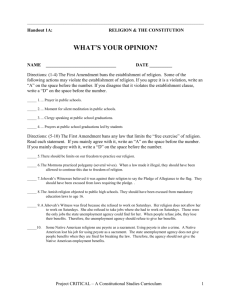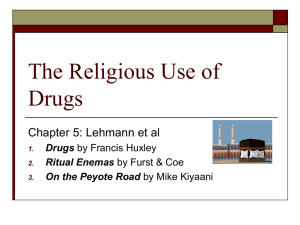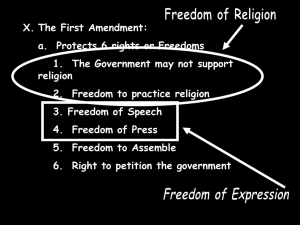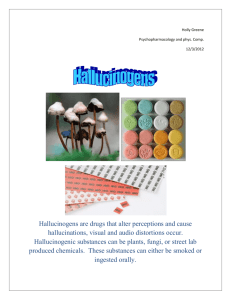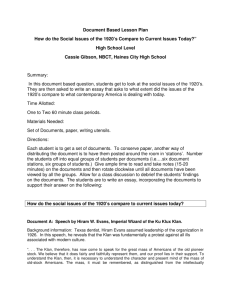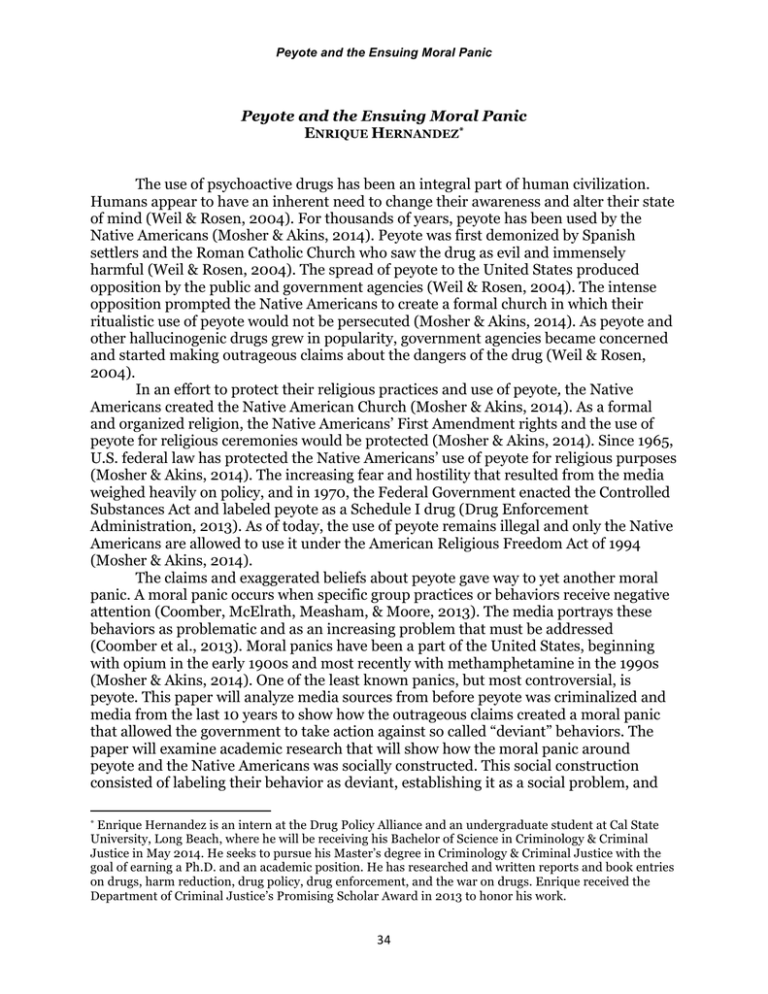
Peyote and the Ensuing Moral Panic
Peyote and the Ensuing Moral Panic
ENRIQUE HERNANDEZ*
The use of psychoactive drugs has been an integral part of human civilization.
Humans appear to have an inherent need to change their awareness and alter their state
of mind (Weil & Rosen, 2004). For thousands of years, peyote has been used by the
Native Americans (Mosher & Akins, 2014). Peyote was first demonized by Spanish
settlers and the Roman Catholic Church who saw the drug as evil and immensely
harmful (Weil & Rosen, 2004). The spread of peyote to the United States produced
opposition by the public and government agencies (Weil & Rosen, 2004). The intense
opposition prompted the Native Americans to create a formal church in which their
ritualistic use of peyote would not be persecuted (Mosher & Akins, 2014). As peyote and
other hallucinogenic drugs grew in popularity, government agencies became concerned
and started making outrageous claims about the dangers of the drug (Weil & Rosen,
2004).
In an effort to protect their religious practices and use of peyote, the Native
Americans created the Native American Church (Mosher & Akins, 2014). As a formal
and organized religion, the Native Americans’ First Amendment rights and the use of
peyote for religious ceremonies would be protected (Mosher & Akins, 2014). Since 1965,
U.S. federal law has protected the Native Americans’ use of peyote for religious purposes
(Mosher & Akins, 2014). The increasing fear and hostility that resulted from the media
weighed heavily on policy, and in 1970, the Federal Government enacted the Controlled
Substances Act and labeled peyote as a Schedule I drug (Drug Enforcement
Administration, 2013). As of today, the use of peyote remains illegal and only the Native
Americans are allowed to use it under the American Religious Freedom Act of 1994
(Mosher & Akins, 2014).
The claims and exaggerated beliefs about peyote gave way to yet another moral
panic. A moral panic occurs when specific group practices or behaviors receive negative
attention (Coomber, McElrath, Measham, & Moore, 2013). The media portrays these
behaviors as problematic and as an increasing problem that must be addressed
(Coomber et al., 2013). Moral panics have been a part of the United States, beginning
with opium in the early 1900s and most recently with methamphetamine in the 1990s
(Mosher & Akins, 2014). One of the least known panics, but most controversial, is
peyote. This paper will analyze media sources from before peyote was criminalized and
media from the last 10 years to show how the outrageous claims created a moral panic
that allowed the government to take action against so called “deviant” behaviors. The
paper will examine academic research that will show how the moral panic around
peyote and the Native Americans was socially constructed. This social construction
consisted of labeling their behavior as deviant, establishing it as a social problem, and
Enrique Hernandez is an intern at the Drug Policy Alliance and an undergraduate student at Cal State
University, Long Beach, where he will be receiving his Bachelor of Science in Criminology & Criminal
Justice in May 2014. He seeks to pursue his Master’s degree in Criminology & Criminal Justice with the
goal of earning a Ph.D. and an academic position. He has researched and written reports and book entries
on drugs, harm reduction, drug policy, drug enforcement, and the war on drugs. Enrique received the
Department of Criminal Justice’s Promising Scholar Award in 2013 to honor his work. *
34 Ramapo Journal of Law and Society
deeming it necessary to take action against the Native Americans and their use of
peyote. Lastly, the paper will address how this panic stirred the criminalization of peyote
and led to a series of U.S. Supreme Court cases (e.g., Employment Division v. Smith,
1990; City of Boerne v. Flores, 1997), in which Native Americans were fighting for their
freedom of religion and their liberty to use drugs.
Creating a moral panic
Fears of the detrimental effects peyote would have on American society were first
portrayed in newspaper reports in the early 1900s. A series of newspaper articles in the
late 1910s and early 1920s, warned that peyote was an evil addicting substance that
caused irrational and violent behaviors, endangered White settlements, destroyed
marriages, and threatened morality. Herbert Welsh’s (1918) Peyote-An Insidious Evil
and the articles “Peyote Bean Causes Frenzy” (Los Angeles Times, 1919) and “Peyote
Used as Drug in Indians’ “Cult of Death”” (The New York Times, 1923) claimed peyote
was evil and the most powerful drug known to man. Welsh (1918) claimed that peyote
caused more harm than whiskey, gambling, and all other substances. The newspapers
described peyote as producing a state of drunkenness and inebriation that could not be
compared with any other drug. The state of drunkenness produced only required a small
dose and often lasted for days. The NY Times article claimed that some of the Native
American users were forced to rest in bed for days in order to recover from the
inebriation.
Peyote was believed to be so powerful and addicting that it was referred to as a
vice, menace, and curse that plagued the Native Americans (Times, 1923; Welsh, 1918).
Peyote addiction was described as so severe that it required the Native Americans to
take “at least twice the ordinary dose of stimulants” (The New York Times, 1923, para.
9). The same articles mentioned that when users were hospitalized, the stimulants used
by the hospital had no effect.
The effects described were greatly exaggerated. According to Mosher and Akins
(2014) “there is little or no evidence” linking peyote to severe reactions and dependence
such as the ones described in the media (p. 144). In small doses, peyote produces
feelings of euphoria and can produce longer lasting effects in higher doses (Ray & Ksir,
2004). Despite claims that peyote has no medical value, research has shown that peyote
has been used to treat alcoholism, and it might even be useful in treating the mentally ill
(Albough & Anderson, 1974; Mosher & Akins, 2014).
In addition to the strength of the drug, these early media reports claimed that
peyote use had many harmful, physical effects (The New York Times, 1923; Welsh,
1918). Among them were tremors, convulsions, paralysis, rapid breathing, visual
disturbances, hallucinations, and even death (The New York Times, 1923; Welsh, 1918).
A string of 25 deaths in 2 years among the Utes were attributed to the use of peyote
(Welsh, 1918). Although there is no conclusive evidence of peyote-related deaths,
research seems to indicate that it is unlikely given that peyote use has no serious effects
or reactions (Mosher & Akins, 2014). Carstairs and Cantrell’s (2010) study on the effects
of peyote reviewed a California Poison Control System database from 1997-2008 and
concluded that no deaths had been attributed to the use of peyote (Carstairs & Cantrell,
2010).
Welsh (1918) claimed that the physical effects caused by peyote were not only
severe but were more apparent and detrimental to those who were depressed or weak.
35 Peyote and the Ensuing Moral Panic
He argued that peyote caused immediate muscle paralysis and made it impossible for
women to give birth to a child. While those effects are not supported by research, a few
other claims made concerning the physical effects of peyote were accurate, such as rapid
breathing, hallucinations, nausea, and vomiting (Mosher & Akins, 2014). Other effects,
such as “pupil dilation and increased body temperature, pulse rate, and blood pressure,”
will only occur when high doses are consumed (Mosher & Akins, 2014, p. 143-144). But,
“there is little or no evidence of physical problems, dependence, or series adverse
reactions to peyote” (Mosher & Akins, 2014, p. 144).
The negative effects of peyote –including nausea and vomiting –tend to be
specific to the set and setting of the peyote using experience. The Native Americans who
use peyote claim “that with repeated use, especially in religious ceremonies, nausea and
vomiting do not occur” (Weil & Rosen, 2004, p. 125). Dr. Zinberg’s (1984) Drug, Set,
and Setting: The Basis for Controlled Intoxicant Use supports the Native Americans’
claims. Dr. Zinberg (1984) argues that the effects of a drug depends on the set (how the
person is feeling) and setting (where the drug is used). The ceremonial setting limits the
effects of peyote to a degree that suits the religious ritual.
The early media claimed that the psychological effects of peyote included
irrationality and mind-control. Peyote also made concentration impossible, destroyed
judgment, destroyed aspirations, and interrupted intellectual development (The New
York Times, 1923). News reports claimed that the drug made the Native Americans so
irrational that they refused any medical treatment (Welsh, 1918). After consuming
peyote, the Native Americans would believe that they had superhuman knowledge and
that peyote was the only remedy that could cure every illness (The New York Times,
1923; Welsh, 1918). According to Welsh (1918), the use of peyote also created “false
notions in the minds of the users, preventing sound logic and rational thought with
which to meet the problems of their daily lives” (p. 4). The claim was that peyote had a
mind controlling effect over its users.
Peyote-using parents, the reports claimed, spread these ideas to their children
(The New York Times, 1923). Thus, the youth also believed that they did not need
treatment from doctors because peyote was the cure for every illness (The New York
Times, 1923). Furthermore, children of peyote-using parents were described as
undeveloped, dull, irresponsible, and unreliable (The New York Times, 1923). However,
research has not shown a direct link between peyote and cognitive problems (Halpern et
al., 2005).
Perhaps the most outrageous claim was that peyote was “responsible for 100% of
the insanity cases at that time” (The New York Times, 1923, para. 9). Recent research
showed that there is no direct link between hallucinogenic drugs and mental health
problems (Krebs & Johansen, 2013). The study actually showed that in some cases,
those who had previously used peyote and/or psychedelic drugs showed lower rates of
mental health deficiencies (Krebs & Johansen, 2013). Halpern, Sherwood, Hudson,
Yurgelun-Todd, and Pope (2005) also provided support against the exaggerated claims
made about the psychological effects caused by peyote. Their study revealed that no
evidence shows that peyote causes psychological or cognitive problems in users.
The most feared effect of peyote was that the high of peyote made Native
Americans violent persons who would come after Whites and their settlements. The
article “Peyote Bean Causes Frenzy” (1919) claimed the Native Americans would go on
violent sprees after using peyote and target residents and White establishments. In a
36 Ramapo Journal of Law and Society
wild state of intoxication, a Native American reportedly went on a rampage in which he
grabbed a weapon and went around town shooting everyone in sight. Many of the wars
and acts of violence in which the Native Americans were involved were attributed to
their use of peyote (Los Angeles Times, 1919). Research does not support any of these
claims. Richard Schultes’ (1938) study concluded that when using peyote, “there is no
tendency to commit acts of violence” (p. 702).
The effects of peyote were also seen as a threat against the traditional values and
morals of the White man. Peyote was seen as having a negative effect on morality. The
use of peyote would make the women promiscuous and destroy marriages (Welsh,
1918). The media described peyote as a threat to the Christian Church, and accused the
Native Americans of replacing the significance of the Bible with peyote (The New York
Times, 1923). The Native Americans were accused of using religion as an excuse to get
high. By claiming that peyote was a part of a religion, it could be used as often as
desired. The reports warned that this would eventually result in a church revolving
around cocaine and other drugs (The New York Times, 1923). Despite these claims,
Mosher and Akins (2014) describe how peyote is used in controlled formal religious
ceremonies.
The moral panic subsides
In comparison to 100 years ago, the media representation of peyote in the 2000s
has shifted. The language and overall tone of the articles that discuss the drug is much
more affirmative, highlighting its successful medical uses and portraying the peyoteinduced experience as fun.
Peyote has received a lot of attention from physicians who seek to study its
medical benefits (Flam, 2003; Krans, 2013). Doctors and researchers agree that it is
important to study the efficacy and safety of hallucinogenic drugs to understand their
effects and expand the tools in the medicine arsenal (Flam, 2003; Kerns, 2013). While
the media clearly indicated 100 years ago that many harms resulted from peyote use,
studies demonstrated little or no long-term effects on the brain from using peyote and
other hallucinogenic drugs. Rather, peyote can be an effective treatment for alcoholism
(Halpern et al., 2005), and peyote users actually show a lower rate of mental health
problems than nonusers (Krans, 2013; Krebs & Johansen, 2013). Use actually lowers the
risks of mental illness (Flam, 2003; Kerns, 2013). Furthermore, news reports indicate
that over the past 100 years, peyote has had no history of abuse, trafficking or addiction,
contradicting many of the early portrayals (Flam, 2003).
Views on peyote have also shifted when it comes to music and television. An
episode of The Sopranos (2007) showed the main character Tony and his mistress
Sonya consuming peyote in a casino hotel room. The way peyote use is portrayed in the
episode is consistent with the most common effects of the drug (Weiner & Chase, 2007).
The characters are seen eating a small dose of peyote, which makes Tony nauseous and
makes him vomit (Weiner & Chase, 2007). After vomiting, Tony experiences euphoria
and is able to continue with his regular activities. Tony and Sonya actually go to a casino
and manage to win money gambling without any problems other than the fact that they
are constantly laughing (Weiner & Chase, 2007). Contrary to the exaggerated views of
the early media, the characters do not experience paralysis or any adverse effect. Rather,
peyote use is portrayed in The Sopranos (2007) in a light and comical way. None of the
initial effects (nausea, vomiting) persisted.
37 Peyote and the Ensuing Moral Panic
The positive outlook on peyote has allowed music festivals and social events such
as Coachella and Burning Man to also be portrayed in a positive way. Despite the known
use of psychedelic drugs, like peyote, these musical events are not advertised negatively
(Krans, 2013). The Multidisciplinary Association for Psychedelic Studies (MAPS), which
was created to promote harm reduction among users of psychedelic and hallucinogenic
drugs (Doblin, 1999), was present at Burning Man to provide assistance to users. While
the early media would represent these volunteers as promoters of drug use, current
media stress that although MAPS was available to provide services, no one required
medical assistance during the festival (Kerns, 2013).
Elements of the peyote moral panic
The United States has experienced many moral panics over the years, as was the
case with opium, cocaine, and crack cocaine. The moral panics have had severe
consequences mostly on racial relations and policy. The moral panics have resulted in
racist and prejudicial policies that lead to the marginalization of minorities (Cohen,
1972; Mosher & Akins, 2014). Despite the number of moral panics experienced, many
have been narrowly avoided. According to Goode and Ben-Yahuda (1994), if the
discussion around an activity does not fit five different criteria—concern, hostility,
consensus, disproportionality, and volatility—then it does not amount to a moral panic.
Given the representation of the portrayal of peyote in the early 20th century, a moral
panic was afoot. However, neither moral panic nor a drug scare around peyote exists
currently.
The first element of a moral panic is concern. This element is characterized by an
increasing concern among the public about a behavior exhibited by a group of people
(Goode & Ben-Yahuda, 1994). In the case of peyote, a heightened concern emerged
when non-Indians began to notice that the Native Americans regularly used peyote. The
issues quickly spread to the media, which began to publish exaggerated claims about its
effects. These outrageous claims created a great amount of concern, which resulted in
fear and eventually led to the second element of a moral panic.
Hostility, the second element of a moral panic is described as “an increased level
of hostility toward the category of people seen as engaging in the threatening behavior”
(Goode & Ben-Yahuda, 1994, p. 157). The emerging hostility resulted from fear of Native
Americans. The early media portrayed the Native Americans as drug users who would
become violent, go on maniacal killing sprees, and try to take over the White man’s land
after consuming peyote (Los Angeles Times, 1919). Morality was also at risk because the
use of peyote was reported to make women promiscuous and cause marriages to end. In
fear of the Native Americans and their use of peyote, the public met them with hostility
and sought to separate from them.
The increasing hostility and fear towards the Native Americans and their use of
peyote created a general consensus (third element) among the public. The majority of
the public believed that peyote was an extremely harmful drug that caused Native
Americans to become maniacs who were capable of anything (Welsh, 1918). It became
clear that actions needed to be taken in order to prohibit the use of peyote and to
prevent the Native Americans from destroying society. The increasing hostility also led
the Native Americans to take action on their behalf. The Native Americans created the
Native American Church (NAC) in order to protect the religion and their use of peyote
38 Ramapo Journal of Law and Society
(Mosher & Akins, 2014). This aggravated the public’s fear because it was seen as an
excuse to use drugs and a threat to Christianity.
The alarming negative consensus against peyote and the Native Americans
quickly sparked the interest of physicians and researchers. Researchers began to study
the effects of peyote and began to notice how disproportionate the fear against peyote
and Native Americans was compared to the effects of the drug on the Native Americans.
This is precisely the fourth element of a moral panic. Disproportionality is characterized
by the realization that the problem was “grossly exaggerated” and the fear and hostility
was disproportionate to the nature of the problem (Goode & Ben-Yahuda, 1994, p. 158).
The fifth element is volatility. Moral panics are described as volatile events, which
suddenly emerge, quickly disappear and suddenly re-emerge. As it relates to peyote, the
moral panic appears to be more localized than other moral panics. The fear surrounding
peyote quickly spread and gave way to a moral panic, but it has yet to re-emerge.
Nonetheless, this moral panic around peyote and the Native Americans did its
damage. The extreme negative attention was the perfect way to generate fear among the
public. The media portrayed the Native Americans as drug users who used religion as a
scapegoat to continue their drug use (The New York Times, 1923). Native Americans
were labeled as maniacs who preyed on innocent people as a result of their drug use
(Los Angeles Times, 1919; The New York Times, 1923). Hostility was imminent. In the
end, the moral panic achieved its goal: the criminalization of peyote and control over the
drug and the Native Americans.
Policy implications
The Native Americans had been consuming peyote in religious ceremonies for
thousands of years. It was not until peyote began to receive negative attention that their
traditions were jeopardized. In order to secure their religious practices, the Native
Americans decided to create a formal church which would be protected under the First
Amendment of the U.S. Constitution (Mosher & Akins, 2014). The Native Americans
created the Native American Church (NAC), a formal organization in which peyote could
still be used (Weil & Rosen, 2004). The federal government acknowledged the Native
Americans efforts and “since 1965, the religious use of Peyote by Native Americans has
been protected by the U.S. federal law” (Mosher & Akins, 2014, p. 143). Since the use of
peyote was only protected by federal law, many Native Americans had to continue their
efforts to extend their rights to the state level (Mosher & Akins, 2014).
Weil and Rosen (2004) claimed that “the explosion of the psychedelic movement
among Indians generated intense opposition by non-Indians” (p. 124). The emerging
moral panic made it easy for the federal government to enact a law against the use of
peyote. The early media had an enormous impact on the public by effectively instilling
fear and promoting hostility towards the Native Americans. As a consensus began to
form, the federal government enacted the Comprehensive Drug Abuse Prevention and
Control Act (Controlled Substances Act) in 1970 (Mosher & Akins, 2014). Under this
Act, the Drug Enforcement Administration created the Federal Drug Schedules, in
which peyote was classified as a Schedule I drug (Mosher & Akins, 2014). Schedule I
drugs are thought to have no medical value and have the highest potential for abuse
(Mosher & Akins, 2014). No evidence exists to support the placement of peyote as a level
one drug. As research has shown, there is no evidence of dependence when referring to
peyote (Mosher & Akins, 2014). As early as 1938, research showed that there is no link
39 Peyote and the Ensuing Moral Panic
between violence and the use of peyote (Schultes, 1938). The scheduling of drugs was
clearly based on the public’s consensus about peyote and not on scientific evidence.
The American Indian Freedom Religious Act of 1978 further protected the use of
peyote and the free exercise of religion of Native Americans (Mosher & Akins, 2014).
The American Indian Freedom Religious Act (1978) protected and preserved the Native
American’s First Amendment right to exercise their religion, possess sacred artifacts,
have access to sacred sites, and worship through ceremonies. In 1990, the Native
Americans challenged their right to use peyote at the state level (Oregon) in the case,
Employment Division of Oregon vs. Smith (Mosher & Akins, 2014). The case centered
on two persons (NAC followers) who were fired from their jobs because of their use of
peyote. The court case began because the two NAC followers wanted to receive
unemployment benefits. In its second decision in the case, the Oregon Supreme Court
held that sacramental peyote use violated the state law prohibition, but also that the
prohibition itself violated the Free Exercise Clause of the Constitution. The United
States Supreme Court subsequently held that the Free Exercise Clause permits the state
to prohibit sacramental peyote use and deny unemployment benefits to the two NAC
followers. The fall-out from the decision was the 1994 amendments of the 1978
American Indian Religious Freedom Act. The 1994 amendments extended the Native
Americans’ rights to the state level. The use, possession, and the transportation of
peyote were now protected by federal and state law.
Despite the numerous laws and amendments protecting the Native American’s
right to use peyote, it remains a Schedule I drug. The government does not recognize all
of the possible medical benefits. Although research has showed that there is no evidence
of dependence, peyote is still regarded as having a high potential for abuse.
Conclusion
While a vast amount of research has shed light on the possible medical uses and
benefits of peyote, there is still no clear consensus on the drug. Peyote has remained
obscured from the public in recent years. One can infer that this is directly related to the
fifth and final element of a moral panic. Volatility, the fifth element, defines a moral
panic as a sudden eruption, which can emerge and disappear at any time (Goode & BenYahuda, 1994). The moral panic around peyote was not as volatile as those with other
drugs such as marijuana and crack cocaine. The moral panic around peyote emerged
slower than most other moral panics and disintegrated slowly after peyote was
prohibited but had the same effects. Recent support of peyote by physicians and
research indicating the possible medical benefits have prompted what many call the
‘New Era’ on peyote (Flam, 2003). Despite these finding, peyote remains a controlled
substance and subject to the punitive laws of the United States.
40 Ramapo Journal of Law and Society
References
American Indian Religious Freedom Act, Public Law No. 95-341, 92 Stat. 469 (1978).
Carstairs, S. D., & Cantrell, F. L. (2010). Peyote and Mescaline Exposures: A 12 Year
Review of a Statewide Poison Center Database. Clinical Toxicology, 48, 350-353.
Center for Disease Control. (2013, August 1). Smoking and Tobacco Use. Retrieved from
http://www.cdc.gov/tobacco/data_statistics/fact_sheets/health_effects/tobacco_relate
d_mortality/.
Cohen, S. (1972). Folk Devils and Moral Panics: The Creation of the Mods and the
Rockers. London: MacGibbon and Key.
Coomber, R., McElrath, K., Measham, F., & Moore, K. (2013). Key Concepts in Drugs
and Society. Los Angeles, CA: Sage Publications Inc.
Doblin, R. (1999). Letters from Rick Doblin, MAPS President. Multidisciplinary
Association Psychedelic Student Bulletin, 9(1), 3.
Flam, F. (2003, December 7). Researchers See ‘New Era’ on Peyote. Philadelphia
Inquirer. Retrieved from http://articles.orlandosentinel.com/2003-1207/news/0312060045_1_peyote-hallucinogenic-huichol.
Goode, E., & Ben-Yahuda, N. (1994). Moral Panics: Culture, Politics, and Social
Construction. Annual Review of Sociology, 20, 149-171.
Halpern, J. H., Sherwood, A. R., Hudson, J. I., Yurgelun-Todd, D., & Pope, H. G. (2005).
Psychological and Cognitive Effects of Long-Term Peyote Use among Native Americans.
Biological Psychiatry, 58(8), 624-631.
Krans, B. (2013, August 22). Psychedelic Drugs Linked to Lower Risk of Mental Illness.
Healthline News. Retrieved from http://www.healthline.com/health-news/mentalpsychedelics-not-linked-to-mental-health-problems-082213.
Krebs, T. S., & Johansen, P. (2013). Psychedelics and Mental Health: A Population
Study. PLoS ONE, 8(8), 1-9. doi:10.1371/journal.pone.0063972.
Mosher, C.J., & Akins, S.M. (2014). Drugs and Drug Policy (2nd ed.). Los Angeles, CA:
Sage Publications Inc.
Peyote Bean Causes Frenzy. (1919, June 22). Los Angeles Times (1886-1922). Retrieved
from http://search.proquest.com/docview/160601632?accountid=10351.
Peyote Used as Drug in Indians’ “Cult of Death.” (1923, January 14). New York Times
(1923-Current File). Retrieved from
http://search.proquest.com/docview/103095276?accountid=10351.
Ray, O.S., & Ksir, C. (2004). Drugs, Society, and Human Behavior (10th ed.). New York,
NY: McGraw Hill.
Schultes, R. E. (1938). The Appeal of Peyote (Lophophora williamsii) as a Medicine.
American Anthropologist, 40(4), 498-715. Retrieved from
http://www.jstor.org/stable/661621.
Weil, A., & Rosen, W. (2004). From Chocolate to Morphine. New York, NY: Houghton
Mifflin Company.
41 Peyote and the Ensuing Moral Panic
Weiner, M. (Writer), Chase, D. (Writer), & Taylor, A. (Director). (2007). Kennedy and
Heidi [Television series episode]. In D. Chase (Producer), The Sopranos, New York, NY:
Home Box Office Inc.
Welsh, H. (1918). Peyote-An Insidious Evil. Philadelphia, PA: Indian Rights
Reservation.
Zinberg, N. E. (1984). Drugs, Set, and Setting: The Basis for Controlled Intoxicant Use.
New Haven, CT: Yale University Press.
42

